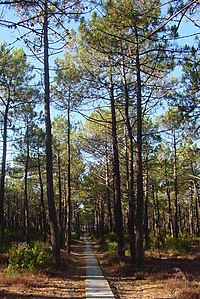
Photo from wikipedia
Recent research undertaken in Mediterranean pine forests suggests that the establishment of Pinus pinea L. and Pinus pinaster Ait. natural regeneration is determined by different spatial and temporal factors. In… Click to show full abstract
Recent research undertaken in Mediterranean pine forests suggests that the establishment of Pinus pinea L. and Pinus pinaster Ait. natural regeneration is determined by different spatial and temporal factors. In this context, we analyzed the establishment and success of natural regeneration in these two species and we examined the hypothesis that the spatial pattern of natural regeneration depends on adult tree presence, density or stand composition, while temporal patterns are typically driven by climatic conditions. For the purposes of the experiment we used 1936 plots of 0.02 ha established in mixed and pure forests of P. pinea and P. pinaster in the Northern Plateau of Spain. Plots were installed following regeneration fellings, and regeneration was monitored annually between 2001 and 2015. We used contingency tables and principal component analysis (PCA) to evaluate the main factors affecting the spatial distribution of the regeneration. PCA was also used to assess the temporal variation as a function of climatic variables. Finally, we checked for the existence of interspecific and intraspecific synchrony through Tau-Kendall synchrony analysis. We found that natural regeneration of P. pinea was more successful than that of P. pinaster over the whole of the studied period. Contingency tables showed that P. pinaster regeneration was associated with conspecific adult trees, while the relationship between P. pinea regeneration and adult trees varied depending on the regeneration development stage, i.e., seedling or saplings. Furthermore, we found that natural regeneration in both species could be enhanced through the presence of mixtures of adult trees. The spatial variability, analyzed through PCA, showed similar responses in both species, although temporal variability associated with climate variables differed between P. pinea and P. pinaster. Finally, we found different synchrony patterns affecting natural regeneration, depending on the species and the regeneration stages. In this context, temporal patterns seem to be species specific during the sapling stage of regeneration. These findings allow the observed regeneration patterns in Mediterranean pinewoods to be generalized at forest management scale.
Journal Title: European Journal of Forest Research
Year Published: 2019
Link to full text (if available)
Share on Social Media: Sign Up to like & get
recommendations!